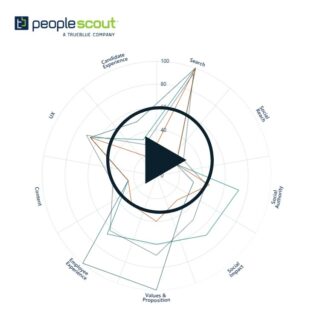Total workforce management is a growing trend, but implementing a total workforce solution is a long-term process. Rather than a one-time implementation, it’s most helpful to think of total talent as an evolution. That evolution will look different for each organization as they work to unite separate parts of a business into one unified strategy.
Learn more about the drivers and benefits of total workforce solutions in our previous blog post. In this post, we’ll cover the major challenges of implementing and maintaining a total talent program – including finding the right technology and total workforce solutions partner.
Total Workforce Solutions Implementation
While there are a host of benefits to a total workforce approach, implementing a holistic program in practice can be complicated. To be successful, there needs to be sponsorship and buy-in from the very top of the organization.
Implementing a total workforce solution starts with understanding your company’s strategic goals and determining how to tailor your talent strategy to achieve those objectives. The way talent wants to work, and the market availability of that talent, will also change your strategy. Understanding the mix of full-time and contingent workers across different departments will allow you to have transparent conversations about how to best find and deploy top talent.
In addition to creating a comprehensive implementation plan, it’s also critical to work with key stakeholders that can help the wider organization understand why a total workforce solution is a positive change and the benefits of evolving to this model. The right messaging, supported by the right data, is critical to success and can help stakeholders work through the difficult conversations that naturally come up as a part of an organizational shift.
The speed of the roll-out will also depend on how your organization is structured. If the structure is already centralized, it will be easier to drive change from the top down. However, for organizations that have decentralized operations, it will be more difficult to get buy-in. The business structure will also impact where in the process an organization needs to start. Some organizations may first need to build a more centralized structure before they can fully build out a total talent solution.
Constant Evolution
Additionally, leaders should keep in mind that the phrase “total workforce evolution” doesn’t just apply to implementation. A well-done total workforce solution is always evolving. The workforce is constantly changing and will continue to change as new generations enter the workforce and more baby boomers and eventually, Gen Xers retire.
Total workforce management is designed to help organizations adjust not just to current change but also adapt to unforeseen changes that will happen decades in the future. That means revaluating how talent wants to work needs to be a constant process. Implementing a total workforce strategy will provide a greater view of a workforce, but leadership needs to recognize that change will continue long past implementation.
The global talent landscape is also changing. Right now, most development of total workforce is happening in the U.S. and Canada, but it could easily spread to other areas around the globe. Organizations will need to keep this in mind as they roll out total workforce and make strategic decisions about how to structure it within the international portions of their business.
Total Workforce Technology
Technology is an important part of any talent acquisition or workforce management solution. Because of this, organizations should find a partner with a proven technology solution and experience building total workforce solutions. Organizations should also plan to evolve their total workforce programs as new technologies come into the marketplace.
Regardless of the specific technology solution, predictive analytics should be a part of any total workforce solution. Predictive analytics can be used in workforce planning to determine whether a certain role is best filled by a full-time employee or as a contract position. The technology can process data about time-to-fill, cost-to-fill, quality of hire and more to determine if the best talent for a role wants to work full-time or as a contingent worker and how to effectively reach those people.
Predictive analytics can also provide an early warning system to let organizations know if they may have issues finding a certain type of talent in a certain location. PeopleScout provides this information to one client that staffs contingent positions around the U.S. By using predictive analytics, PeopleScout is able to spot the early signs of contingent labor shortages in certain key markets and advise that organization to raise wages and add suppliers in strategic locations.
Finding a Total Workforce Solutions Partner
If you’re implementing a total workforce solution at your organization, it is important to work with someone who has experience in total workforce planning.
Additionally, it’s important to ensure your partner has experience with the types of roles and the challenges you’re facing. A total workforce solution will look vastly different for an organization with highly skilled employees and creative contract workers compared with an organization that employs web developers and staffs distribution centers with contingent workers. To be effective, you total workforce partner needs understand both your specific talent needs and the entire process of implementing a total workforce solution. To make sure they can accomplish what you’re looking for, it is also important to establish that they are market leaders, innovators and thought leaders. Because total talent is a growing trend, you want a partner who is innovating and leading in the industry.



